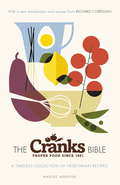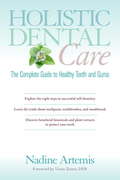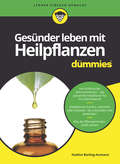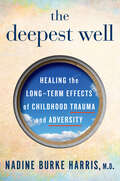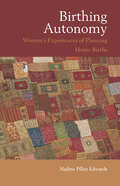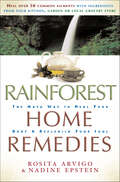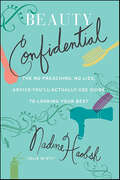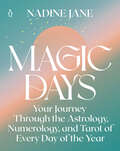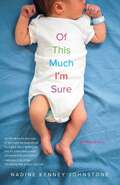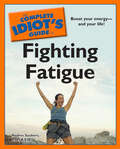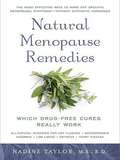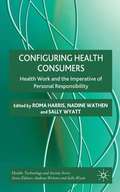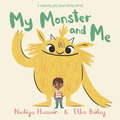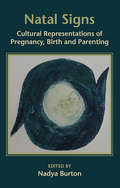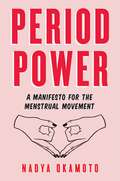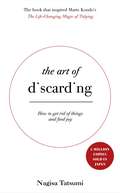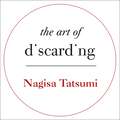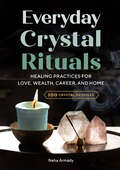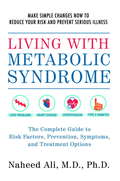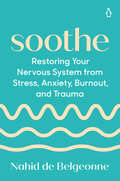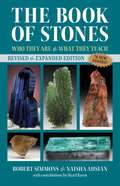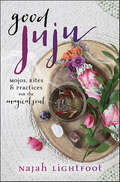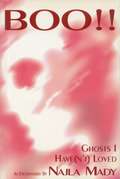- Table View
- List View
The Cranks Bible: A Timeless Collection of Vegetarian Recipes
by Nadine AbensurA classic collection of healthy and delicious plant-based recipes from the Cranks kitchenSince opening their first restaurant in 1961, Cranks have been pioneers of vegetarian cuisine and champions of organic produce. Here, celebrated writer and chef Nadine Abensur presents over 200 classic meat-free recipes from the Cranks kitchen. From pumpkin and parsley risotto to aubergines with smoked ricotta, passion fruit ice-cream, walnut and raisin loaves and plum jam, every recipe is packed full of beautifully simple, natural ingredients that will nourish both body and soul. With advice on selecting the freshest seasonal produce, eating healthily and enjoying the experience of making mouth-watering food, THE CRANKS BIBLE is a celebration of vegetarian cooking and an essential resource for every home.
Holistic Dental Care: The Complete Guide to Healthy Teeth and Gums
by Nadine Artemis Victor ZeinesA comprehensive guide to natural, do-it-yourself oral care, Holistic Dental Care introduces simple, at-home dental procedures that anyone can do. Highlighted with fifty-three full-color photos and illustrations, this book offers dental self-care strategies and practices that get to the core of the problems in our mouths--preventing issues from taking root and gently restoring dental health. Based on a "whole body approach" to oral care, Holistic Dental Care addresses the limits of the traditional approach that treats only the symptoms and not the source of body imbalances. Taking readers on a tour of the ecology of the mouth, dental health expert and author Nadine Artemis describes the physiology of the teeth and the sources of bacteria and decay. Revealing the truth about the artificial chemicals in many toothpastes and mouthwashes, Artemis also discusses the harmful effects of mercury fillings and the much safer ceramic filling options that are available. Covering topics that include healthy nutrition, oral care for children, and the benefits of botanical substances and plant extracts for maintaining oral health, Artemis introduces a comprehensive eight-step self-dentistry protocol that offers an effective way to prevent decay, illness, acidic saliva, plaque build-up, gum bleeding, inflammation, and more.
Gesünder leben mit Heilpflanzen für Dummies (Für Dummies)
by Nadine Berling-AumannOb Herpes, Husten oder Harnwegsinfektion - Mutter Natur hat fast jedem Wehwehchen und vielen Krankheiten etwas entgegenzusetzen. Da gibt es Wermut gegen Krämpfe, Ingwer gegen Übelkeit oder Senf gegen Nervenschmerzen. Doch welche Pflanze hilft wirklich, wo bekomme ich sie her, wie wende ich sie an und wie wirkt sie eigentlich? Dieses Buch erklärt Ihnen wissenschaftlich fundiert und dennoch leicht verständlich alles, was Sie über Heilpflanzen wissen müssen. Neben einer allgemeinen Einführung über Heilpflanzen, deren Inhaltsstoffe und Co. erfahren Sie zum Beispiel auch Interessantes über die verschiedenen Medizinsysteme mit Heilpflanzen, die es auf der Welt gibt. Im Herzstück des Buches finden Sie für jedes Beschwerdebild ein entsprechendes Kapitel, das Ihnen genau zeigt, welche Pflanzen Ihnen wie helfen können. Egal, ob Sie sich privat oder beruflich mit Heilpflanzen beschäftigen wollen, mit diesem Buch haben Sie den perfekten Ratgeber zur Hand.
The Deepest Well: Healing the Long-Term Effects of Childhood Adversity
by Nadine Burke HarrisA pioneering physician reveals how childhood stress leads to lifelong health problems and what we can do to break the cycle. Dr. Nadine Burke Harris was already known as a crusading physician delivering targeted care to vulnerable children. But it was Diego—a boy who had stopped growing after a sexual trauma—who galvanized her to dig deeper into the connections between toxic stress and the lifelong illnesses she was tracking among so many of her patients and their families. A survey of more than 17,000 adult patients’ “adverse childhood experiences,” or ACEs, like divorce, substance abuse, or neglect, had proved that the higher a person’s ACE score the worse their health—and now led Burke Harris to an astonishing breakthrough. Childhood stress changes our neural systems and lasts a lifetime. Through storytelling that delivers both scientific insight and moving stories of personal impact, Burke Harris illuminates her journey of discovery, from research labs nationwide to her own pediatric practice in San Francisco’s Bayview-Hunters Point. For anyone who has faced a difficult childhood, or who cares about the millions of children who do, the innovative and acclaimed health interventions outlined in The Deepest Well will represent vitally important hope for change.
Birthing Autonomy: Women's Experiences of Planning Home Births
by Nadine EdwardsBirthing Autonomy brings some balance to the difficult arguments that arise from debates about home births, and focuses on women’s views and their experiences of planning home births. It provides an in-depth exploration of how women make decisions about home births and what aspects matter most to them. Comparing how differently the pros and cons of home births are constructed and contemplated by mothers and by the medical profession, the book looks at how current obstetric thinking and practices can disempower and harm women emotionally and spiritually as well as physically. Written in an accessible style, this book is enlightening for student and practicing midwives and obstetricians, as well as researchers and students of nursing, medical sociology, health studies, gender studies, feminist practitioners and theorists. It will also be invaluable to expectant mothers who want to be more informed about the choices they are facing and the wider context within which their birth options are considered.
Rainforest Home Remedies: The Maya Way to Heal Your Body & Replenish Your Soul
by Rosita Arvigo Nadine EpsteinRainforest Healing from Your Home and Garden Find alternatives to chemical anti-depressants and painkillers in your spice rack. Learn about natural anti-itch salves for insect bites. Soothe and relieve envy, grief, sadness, and fear the Maya way. Rid your house of negative energy with a Maya cleansing ritual. Try the easy-to-make bronchitis remedy.
Beauty Confidential: The No Preaching, No Lies, Advice-You'll-Actually-Use Guide to Looking Your Best
by Nadine HaobshRenowned beauty expert Nadine Haobsh has the answers to the world's really BIG questions:How much should I tip my hair stylist (and the shampoo girl and the colorist)?How red can I go before my lips make me look too vampy?What's the best perfume for my lifestyle?What's the proper method for using that most important beauty accessory, the eyelash curler?Is it ever too early to get Botox?Forget celebrity trends and complicated how-to books. In Beauty Confidential, Nadine names names and provides the inside scoop on the products that are worth it and those to forget. In this must-have handbook for the modern girl, she offers industry secrets and insider tips on everything beauty—from how to make a dye job last to finding the ideal mascara to creating the perfect ponytail—fearlessly debunking with wit, style, and smarts the common beauty myths perpetuated by the top magazines. With Nadine's expert guidance and priceless secrets, you'll learn how to put yourself together flawlessly in under ten minutes . . . and you'll have the best skin and hair at any age!
Magic Days: Your Journey Through the Astrology, Numerology, and Tarot of Every Day of the Year
by Nadine JaneFrom celebrated astrologer Nadine Jane, a guide to the journey of every day and birthday of the year, revealing how the current astrological season, along with the wisdom of tarot and numerology, can help you lead a happier and more fulfilled lifeFans and celebrities alike flock to Nadine Jane for custom astrological readings that focus on self-understanding, self-empowerment, and self-care. Now, for the first time, readers have access to her insights in this comprehensive guide to the inherent magic of every day of the year, unveiling the daily inspirations, challenges, and guides that will help you take care of yourself every day. For each day of the year, you&’ll discover guidance for the day&’s particular journey based on the astrology, tarot, and numerology, along with a mantra, a ritual, and a journaling prompt, so you can home in on the lessons and wisdom that come from that particular moment in time, whether it's Capricorn or Aries season. You&’ll also find special information if it&’s your birthday, so you can take the day&’s celestial wisdom to heart when it comes to your personal journey, relationships, goals, and dreams. Whether you&’re a novice looking for your first introduction to spiritual practices, a lost soul who could use some direction in life, a jaded expert looking for a bird's-eye view of the topics you know far too well, an empathic people-reader who loves to understand others, or a complete skeptic who considers this &“spiritual nonsense&” while secretly delighting in the inexplicable accuracy of it all, you&’ll find something for every day of your luminous life in Magic Days.
Of This Much I'm Sure: A Memoir
by Nadine Kenney JohnstoneAt twenty-two, Chicagoan Nadine Kenney is thrilled to meet her future husband, Jamie, while vacationing in Florida. After a whirlwind, long-distance romance, Nadine leaves her friends, family, and city to join Jamie in suburban Massachusetts. Once married, they begin trying for a baby without knowing how hard that road will become. Nadine soon faces the little-known horrors of IVF when a procedure causes severe internal bleeding, and she wakes up from emergency surgery with a six-inch scar instead of a baby bump. In the difficult year that follows, anxiety and additional failed fertility treatments threaten her new marriage and her mental state. By some saving grace, she eventually becomes pregnant naturally, but the horrors are not over: her son is diagnosed with potentially terminal kidney complications. Ultimately, Nadine learns that in an unpredictable life, the only thing she can be sure of is the healing power of hope.
The Complete Idiot's Guide to Fighting Fatigue: Boost Your Energy—and Your Life!
by Nadine SaubersA boost of energy for your customers (and your sales) Exhaustion is rampant nowadays—for both medical and lifestyle reasons. In this helpful guide, a healthcare professional and scientific researcher explains the common causes of fatigue, both physical and emotional—and the most effective ways to prevent and combat it. Readers will be able to recognize the warning signs of systemic fatigue; figure out when medical treatment is required; learn lifestyle solutions; discover alternative therapies; and consult a resource section for even more information. • Expert author brings an integrated approach—both traditional and alternative—to the prevention and treatment of fatigue • Can be used by the millions of people suffering from such conditions as fibromyalgia
Natural Menopause Remedies
by Nadine TaylorLearn the most effective ways to ward off specific menopausal symptoms? without the use of synthetic hormones. We learned the bad news: Women on Hormone Replacement Therapy have a higher risk of heart disease, blood clots, stroke, and breast cancer than those who are not. Some six million women were taking synthetic hormones (HRT) when the news broke. And the Women?s Health Initiative, a prestigious, long-term study of 16,000 women, had to stop three years earlier than planned, leaving millions of women unsure what to do next. But there is good news. Women can use all natural remedies for their hot flashes, insomnia, heart disease, osteoporosis, low libido, and vaginal dryness?without risking serious side effects. Natural Menopause Remedies uncovers the truths and myths about nature?s remedies, including foods, herbs, supplements, lifestyle changes, and alternative techniques. Based on clinically proven evidence drawn from thorough research, this book reveals which natural remedies work, how they work, and how to use them. With the information in this book, women can implement a personalized plan for their specific symptoms. Learn the most effective ways to ward off specific menopausal symptoms? without the use of synthetic hormones. We learned the bad news: Women on Hormone Replacement Therapy have a higher risk of heart disease, blood clots, stroke, and breast cancer than those who are not. Some six million women were taking synthetic hormones (HRT) when the news broke. And the Women?s Health Initiative, a prestigious, long-term study of 16,000 women, had to stop three years earlier than planned, leaving millions of women unsure what to do next. But there is good news. Women can use allnatural remedies for their hot flashes, insomnia, heart disease, osteoporosis, low libido, and vaginal dryness?without risking serious side effects. Natural Menopause Remedies uncovers the truths and myths about nature?s remedies, including foods, herbs, supplements, lifestyle changes, and alternative techniques. Based on clinically proven evidence drawn from thorough research, this book reveals which natural remedies work, how they work, and how to use them. With the information in this book, women can implement a personalized plan for their specific symptoms. .
Configuring Health Consumers
by Roma Harris Nadine Wathen Sally WyattThis book explore assumptions underpinning contemporary health policy discourses that emphasize personal responsibility for health, consider how they attach to changing information technologies, and discuss their influence on emerging forms of health 'work'.
My Monster and Me
by Nadiya HussainThe very first picture book from the winner of The Great British Bake Off and national treasure, Nadiya Hussain, beautifully illustrated by Ella Bailey.A touching story about a little boy whose worry monster follows him everywhere he goes. It's there when he gets dressed, when he wants to play with his toys, and even when his friends come over to visit. How can he escape his worries?Having suffered with panic disorder herself for as long as she can remember, Nadiya wrote this heartfelt story to help give children and parents the tools they need to talk about worries and anxiety, to ensure that no child suffers in silence.
Natal Signs: Cultural Representations Of Pregnancy, Birth And Parenting
by Nadya BurtonNatal Signs: Cultural Representations of Pregnancy, Birth and Parenting explores some of the ways in which reproductive experiences are taken up in the rich arena of cultural production. The chapters in this collection pose questions, unsettle assumptions, and generate broad imaginative spaces for thinking about representation of pregnancy, birth, and parenting. They demonstrate the ways in which practices of consuming and using representations carry within them the productive forces of creation. Bringing together an eclectic and vibrant range of perspectives, this collection offers readers the possibility to rethink and reimagine the diverse meanings and practices of representations of these significant life events. Engaging theoretical reflection and creative image making, the contributors explore a broad range of cultural signs with a focus on challenging authoritative representations in a manner that seeks to reveal rather than conceal the insistently problematic and contestable nature of image culture. Natal Signs gathers an exciting set of critically engaged voices to reflect on some of life’s most meaningful moments in ways that affirm natality as the renewed promise of possibility.
Period Power: A Manifesto for the Menstrual Movement
by Nadya Okamoto Rebecca ElfastPERIOD founder and Harvard College student Nadya Okamoto offers a manifesto on menstruation and why we can no longer silence those who bleed—and how to engage in youth activism.Throughout history, periods have been hidden from the public. They’re taboo. They’re embarrassing. They’re gross. And due to a crumbling or nonexistent national sex ed program, they are misunderstood. Because of these stigmas, a status quo has been established to exclude people who menstruate from the seat at the decision-making table, creating discriminations like the tampon tax, medicines that favor male biology, and more. Period Power aims to explain what menstruation is, shed light on the stigmas and resulting biases, and create a strategy to end the silence and prompt conversation about periods.
OHSAS 18001 Step by Step
by Naeem SadiqWe say 'take care' as we wave our loved ones goodbye in the morning, but how often is this message taken into the workplace? In this easy-to-understand and timely pocket guide, Naeem Sadiq, examines the practical and managerial issues an organisation faces as it gears up to meet OHSAS 18001 standards of occupational health and safety. Using a wide variety of fictional 'real world' scenarios, Sadiq demonstrates the hazards that might be present in a workplace, how to assess risk, how to manage OHSAS 18001 implementation and how to communicate its implementation through all levels of management. Sadiq takes the complex, and often impenetrable, concepts that surround health and safety and presents them with absolute precision and clarity. OHSAS 18001: Step by Step is more than a primer. Besides giving the reader a sound understanding of OHSAS 18001, the pocket guide can be used as a step-by-step instructional manual for anyone tasked with implementing operational health and safety standards in the workplace.
The Art of Discarding: How to get rid of clutter and find joy
by Nagisa TatsumiThe original Japanese edition of The Art of Discarding, titled Suteru! Gijutsu, was published in 2000 and became an overnight sensation - selling a million copies in six months and inspiring a young Marie Kondo. The book has since become a multimillion-copy international bestseller, but it has never been translated into English, until now. In this guide to living a calmer, more ordered life, renowned author Nagisa Tatsumi teaches us how letting go of unwanted things will transform our day-to-day happiness. The book offers practical advice and techniques to help readers learn to let go of stuff that is holding them back, as well as tips for acquiring less in the first place.It's time to live with less.
The Art of Discarding: How to get rid of clutter and find joy
by Nagisa TatsumiA combination of tiny homes and a love of stylish homeware has left Japanese people hungry for advice on organization, decluttering and tidying up. Indeed, in this era of mass consumption, we are all drowning in 'stuff', despite our best efforts to keep on top of the clutter that collects in our homes, our office spaces and even our cars. All this clutter causes us mental anguish, however, as we all know, throwing things away can be difficult - it clashes with the values instilled in us from an early age of not wasting things, reusing items, and keeping things 'for a rainy day' - simply put, we feel guilty about getting rid of things. Enter Nagisa Tatsumi and her bold suggestion - that it's OK to throw stuff away.Tatsumi's book 'Suteru Gijyutsu', or The Art of Discarding, was a sensation when it was published in Japan, selling 1 million copies in the first six months after publication in 2000. In it, she argues that we need to learn to let go, and tackles head-on the psychological issues that people have with getting rid of things, in particular a reluctance to discard things 'just in case', the desire to hoard things, and guilt about getting rid of things that were given as gifts.The book offers practical advice and techniques to help readers learn to let go of stuff that is holding them back, as well as advice on acquiring less in the first place; if we buy less, there's less to get rid of. She takes readers through a step-by-step process of getting rid of household items, clothes, books - and promises a clutter-free, calmer life where we are free from 'accumulation syndrome' and ultimately, less is more.(P) 2017 Hodder & Stoughton
Regenerative Medicine and Stem Cell Biology: Bench To Bedside (Learning Materials in Biosciences #0)
by Nagwa El-BadriThis textbook covers the basic aspects of stem cell research and applications in regenerative medicine. Each chapter includes a didactic component and a practical section. The book offers readers insights into: How to identify the basic concepts of stem cell biology and the molecular regulation of pluripotency and stem cell development. How to produce induced pluripotent stem cells (iPSCs) and the basics of transfection. The biology of adult stem cells, with particular emphasis on mesenchymal stromal cells and hematopoietic stem cells, and the basic mechanisms that regulate them. How cancer stem cells arise and metastasize, and their properties. How to develop the skills needed to isolate, differentiate and characterize adult stem The clinical significance of stem cell research and the potential problems that need to be overcome. Evaluating the use of stem cells for tissue engineering and therapies (the amniotic membrane) The applications of bio-nanotechnology in stem cell research. How epigenetic mechanisms, including various DNA modifications and histone dynamics, are involved in regulating the potentiality and differentiation of stem cells. The scientific methods, ethical considerations and implications of stem cell research.
Everyday Crystal Rituals: Healing Practices for Love, Wealth, Career, and Home
by Naha ArmádyManifest desires with crystal healing prescriptions for your home, career, and relationship from Everyday Crystal Rituals. Crystal rituals channel inner desires to create outward change. In Everyday Crystal Rituals, you'll learn practical applications to crystal healing and manifest the life you want to lead at home, work, and in love. From mending broken hearts, to removing career obstacles, to inviting creativity into your home, these rituals make sacred practices part of your daily routine. Complete with 100 crystal profiles that explain their individual healing powers, plus an introduction on tuning into crystal energy, Everyday Crystal Rituals is your down-to-earth guide for healing with crystals. Everyday Crystal Rituals awakens your ability to live in fulfillment, love, and abundance with: An introduction to crystal healing that explains how to call on crystal energy and manifest powerful intentions with purpose. 60 rituals for focused healing of real obstacles around love and relationships, career, wealth, and home life. 100 profiles of the most common crystals with practical information on how to use them to achieve your life goals. Whether you're new to working with crystals or they're already a big part of your life, Everyday Crystal Rituals makes manifesting positive change a daily ritual.
Living with Metabolic Syndrome
by Naheed AliTHE FIRST TRULY COMPREHENSIVE RESOURCE FOR METABOLIC SYNDROME PATIENTSAffecting well over 50 million Americans, the series of conditions known as metabolic syndrome has reached epidemic proportions. Found in patients where increased blood pressure, high blood sugar level, excess body fat, and abnormal cholesterol level occur together, metabolic syndrome increases the risk of heart disease, stroke and diabetes. With so many conditions working together, and no set list of identifiable symptoms, the best defense against metabolic syndrome is information--understanding the need for proper diet, exercise, and wellness checks. So long as patients at risk of developing metabolic syndrome understand their risk factors, they can work to prevent the syndrome and restore their good health.Incorporating information from all the latest research and treatment options, Living with Metabolic Syndrome is the breakthrough guide to understanding this ever-growing health problem. This comprehensive manual takes advantage of new findings from both clinical and physician studies while providing guidance in clear, authoritative language. Touching on every aspect of metabolic syndrome, including: risk factors and possible symptoms; doctor's visits, including choosing a specialist; and dealing with the emotional/psychological strain of long-term illness, Living with Metabolic Syndrome offers powerful techniques and real-world advice that sufferers can immediately relate to.Living with Metabolic Syndrome covers:* Detailed information on the risk factors for metabolic syndrome, including diet, lifestyle and heredity* The variety of possible symptoms, such as fatigue and low appetite, which can accompany the syndrome* Treatment options, both medical and holistic, including the latest research discoveries and updatesThe essential steps after receiving a diagnosis of metabolic syndrome, including a quick-start 10-step checklist* The role that each doctor and specialist will play in your diagnosis and treatment regimenProviding not only knowledge and hope, but new and practical ways of confronting and living with the syndrome, Living with Metabolic Syndrome lets you reclaim your health, your energy, and your life.From the Trade Paperback edition.
Soothe: Restoring Your Nervous System from Stress, Anxiety, Burnout, and Trauma
by Nahid de BelgeonneIn the age of anxiety, self-soothing and nervous system regulation helps usIs it a struggle to relax, even while on vacation? Do you feel irritable constantly, like the slightest inconvenience might set you off? Do you have shallow breaths, trouble sleeping, and aches that won't go away? If the answer to any or all of these questions is yes, your nervous system might be dysregulated. Soothe shows how to bring it back into balance—and experience a calmer, more resilient way to be.Breaking down the fascinating workings of our nervous system and the brain-to-body connection, where emotions are stored, somatic practicioner Nahid de Belgeonne teaches you how to physically release stress by tapping into your senses, breath, and movement. Along the way, she introduces sustainable micro-practices and daily exercises for self-soothing, including how to: • Rewire your brain with micro-movements • Alter your emotions by modulating your breath• Incorporate mood-enhancing foods into your diet • Co-regulate your nervous system with the people around youStress and anxiety are inevitable, but they don't have to throw us off balance. Soothe invites us into greater bodily awareness and peace.
The Book of Stones: Who They Are and What They Teach
by Robert Simmons Naisha Ahsian• Explores 455 crystals, minerals, gemstones, and their metaphysical energies, including vivid color photographs for each stone • For each stone, shares its scientific information, its element and chakra correspondences, its history, and its physical, emotional, and spiritual benefits • Includes guidance on how to work with crystals and stones and also explores the concept of crystal resonance Offering an illuminating alphabetical journey through the mineral kingdom, this comprehensive reference guide takes you deep into the world of crystals and their uses for spiritual awakening and self-healing. Exploring 455 gemstones and their metaphysical energies, the encyclopedia includes vivid color photographs for each stone to aid identification and showcase its beauty, as well as listing each gem&’s physical, emotional, and spiritual benefits. The book begins with two introductory chapters by authors Naisha Ahsian and Robert Simmons detailing how to work with crystals and stones and exploring the concept of crystal resonance. Each stone entry includes the mineral name and photo, its elemental and chakra correspondences, keywords that indicate its properties, and a description of the crystal structure, hardness, history, and known locations of each mineral, plus any relevant legend or lore from the past. Each author then offers personal insights on the subtle energy properties and spiritual applications of the stone. The entries conclude with the spiritual, emotional, and physical healing qualities of the stone and an affirmation for evoking its potential benefits. This edition also includes an index of the stones&’ healing and energetic properties, making it easy to find the stone best suited to your needs.
Good Juju: Mojos, Rites & Practices for the Magical Soul
by Najah LightfootSpiritual Rites, Spell Work, and Folk Practices to Enhance Your Well-Being and Personal PowerLearn to better express your spirituality and build up your magical practice with this book's powerful spells, rituals, and tools. Designed to help you navigate whatever ups and downs life throws your way, Good Juju is your perfect choice for learning to embrace nature, the old ways, and the magick all around you.Using simple practices that don't interfere with any religions, Good Juju helps you lay a foundation for daily ritual work. You'll also learn how to craft mojos, create and work with altars, tune in to your intuition, and much more. Author Najah Lightfoot guides you in keeping your mind, body, and spirit strong as you discover your magical work and align with your higher power.
Boo!!: Ghosts I Have(n't) Loved
by Najla MadyBOO!! is a collection of true ghost stories by Najla Mady, Canada’s very own ghostbuster. From voodoo rituals, infant possession, to the antics of gentle, benign spirits, including the famous love affair of Captain Swayze from the War of 1812, who entertained many a guest at the Angel Inn at Niagara-on-the-Lake, Najla recites here a few of her more entertaining ghostly encounters. Najla Mady has been much courted by the media. On her own weekly TV show, A Psychic Hour with Najla, she predicted the assassination of Anwar Sadat. When she is not doing personal counselling, she exorcizes ghosts from homes and other places. EXORCIZES GHOSTS??! Is that the activity of a sane, rational personality, you might ask? Anyone who has had the delight of working with Najla will describe a most down-to-earth person. No dippy, chanting, star-gazing fanatic, this woman. BOO!! represents a departure for most of the literature available in this genre because it is not sensationalist. Najla’s single purpose is to help demystify the world of parapsychology for us ordinary folk who live only (and perhaps regrettably) in the obvious, physical realm.
